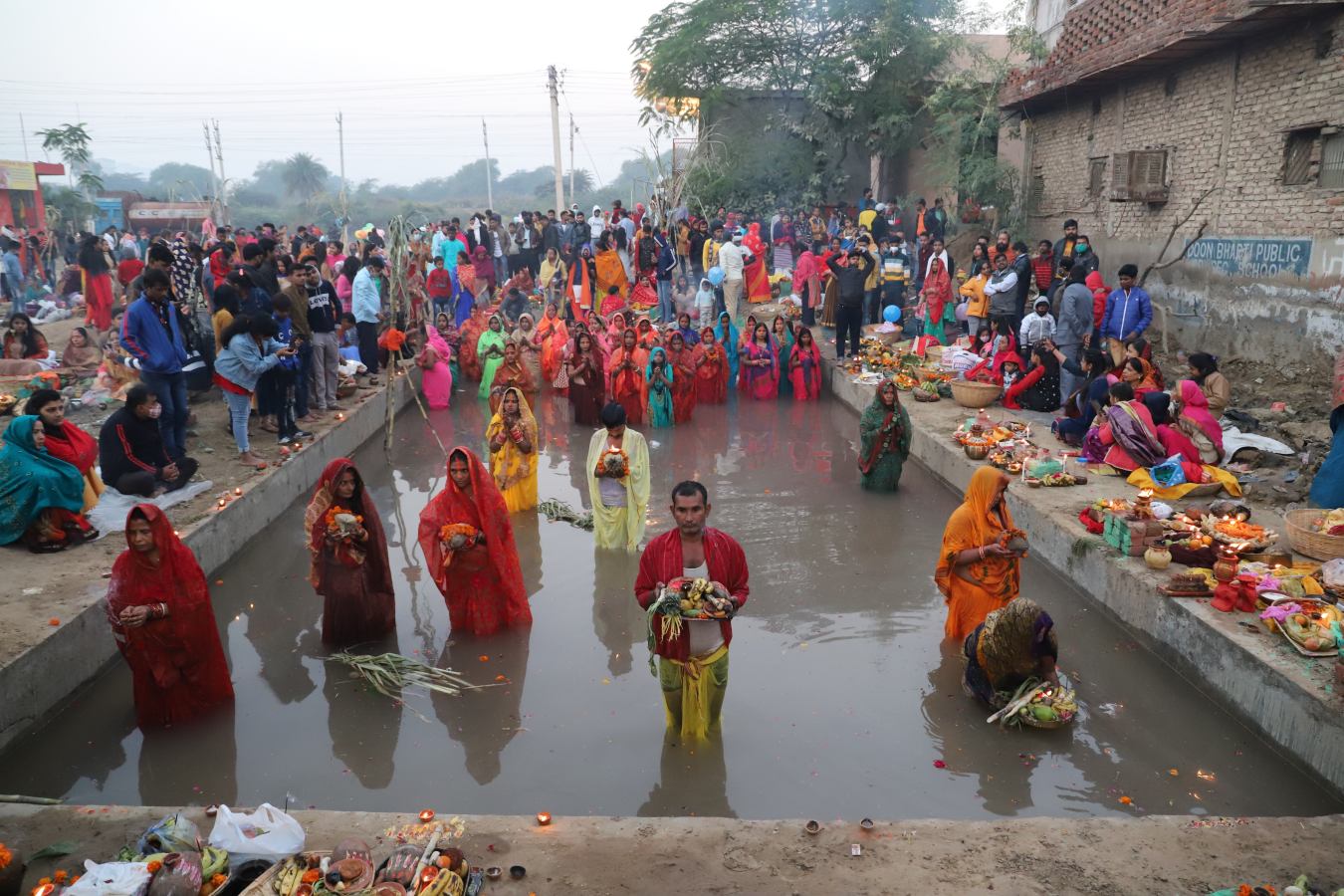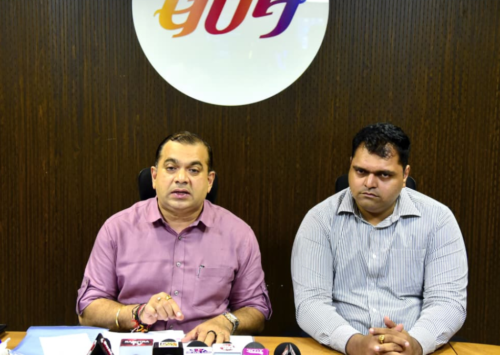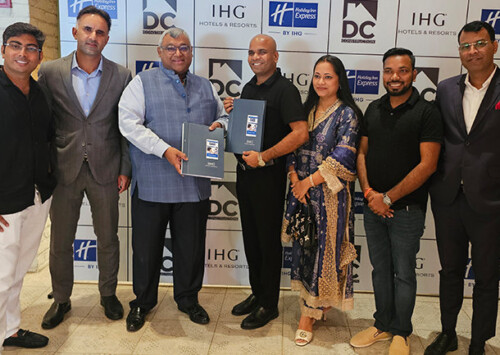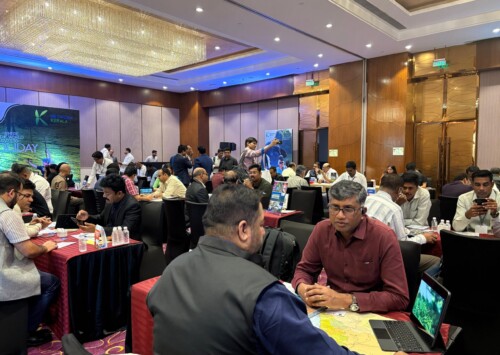Manipulated data, ponds of drinking water: BJP’s clean environment measures in Delhi
Jeopardising residents’ health, government indulges in fake claims

According to reports, a fake ghat was created at Vasudev Ghat, a walled-off section filled with filtered, drinking water from the Sonia Vihar treatment plant, made ready for photo opportunities and VIP visits
Delhi’s pollution crisis has long been a political blame game, but the lines between accuser and accused are now blurred. After years of attacking the Aam Aadmi Party for neglecting the city’s environment, the Bharatiya Janata Party led Delhi government now stands accused of hiding real state of environment behind glossy optics and manipulated data.

According to reports, a fake ghat was created at Vasudev Ghat, a walled-off section filled with filtered, drinking water from the Sonia Vihar treatment plant, made ready for photo opportunities and VIP visits
As has been the norm over the past many years, in the days following Diwali this year, too, Delhi reclaimed the dubious title of the city or at least the capital with the worst air pollution in the world, a status that it ‘earns’ every year after a boisterous, smoke-filled Diwali.
And instead of initiating concrete measures, including long-term solutions for the perennial problem of Delhi’s water and river pollution, the ruling Bharatiya Janata Party has been accused of manipulating data all around to showcase a ‘clean’ Delhi.
According to various videos that have been viral on the social media, Delhi Government has tried to curb the measured levels of air pollution by spraying water at and near the air pollution gauges placed at various spots. It has also been accused of creating a chimera of a clean Yamuna River for the recently-held Chhath Puja, including creating a special bathing area, filled with filtered, potable water so that Prime Minister Narendra Modi could take a dip in it during the festival and proclaim the river to have been cleaned for the first time-ever.
Critics, including opposition leaders and environmentalists say that the government appears more concerned with image than impact and say that there is a worrying pattern of whitewashing rather than genuine measures to curb pollution.
Ironically, the BJP itself had long criticised the Aam Aadmi Party (AAP) government for the very same actions it is now accused of repeating. When AAP was in power, BJP leaders often condemned its environmental measures as superficial, from chemical sprays on the Yamuna to temporary smog-control drives. But since taking control of the capital, the BJP has quietly adopted those same quick fixes while continuing to blame AAP for Delhi’s pollution crisis.
What has changed, critics say, is not the policy, but the propaganda.
Spraying the problem away: Fake clean-ups and failed experiments
Not long ago, BJP leaders accused AAP of covering up the Yamuna’s pollution by spraying anti-foaming chemicals to suppress the thick white froth that forms each winter. This foam, caused by untreated sewage and industrial waste, has long symbolised Delhi’s environmental decay.
But, over the past few weeks, the BJP-led administration itself has been using the same method, deploying tankers of defoaming agents to make the river look clean ahead of Chhath Puja.
Officials boasted that the Yamuna was now fit for bathing and worship, releasing selective water-quality data to support the claim. According to reports, a fake ghat was created at Vasudev Ghat, a walled-off section filled with filtered, drinking water from the Sonia Vihar treatment plant, made ready for photo opportunities and VIP visits. Ordinary devotees, however, still had to deal with the real river where froth and filth persisted. AAP leaders accused the BJP of staging cleanliness instead of actually cleaning the river.
“The construction of an artificial pond with trucked-in clean water for Chhath Puja, 50 metres from a Yamuna foaming with 76,000 MPN/100ml fecal coliform, according to report by CPCB in October, is a damning indictment of priorities. During the 2020 lockdown, Yamuna’s levels of dissolved oxygen, a measure of its health and hygiene, rose from 2 mg/L to 8 mg/L in 60 days without a single rupee spent, proving that cessation of industrial effluent, of about 1,200 million litres a day and sewage bypass is the only scalable solution. Yet, 15 Sewage Treatment Plants remain non-functional, and 44 pc of Delhi’s sewage still flows untreated,” Verhaen Khanna, President of the New Delhi Nature Society, an environmental organisation based in New Delhi, tells Media India Group.
Also Read: Students unhappy with Supreme Court ruling on NEET
“Building a temporary mirage while the river dies reveals a governance model that values photo-ops over floodplains. True restoration requires zero-liquid discharge for industries, wetland revival, and criminal liability for polluters, not chlorinated pools for faith,” he adds.
A similar pattern emerged in the city’s air-quality management. During previous years, BJP leaders often accused AAP of failing to tackle Delhi’s smog. Now the government has itself been caught in controversy over alleged manipulation of air-quality data. New monitoring stations were installed in greener areas like JNU and IGNOU, while heavily polluted zones were overlooked.
On Diwali night, one AQI station at Nehru Nagar reportedly recorded a staggering 1,763 before being mysteriously shut down. Footage of officials spraying water near the Anand Vihar monitoring post, a move that can temporarily lower particulate readings also went viral. Although the government denied wrongdoing, the sudden drops in data raised doubts about the credibility of official pollution figures.
“The deliberate spraying of water near AQI monitors to suppress PM2.5 and PM10 readings constitutes scientific fraud and a direct assault on public health intelligence. Real-time air quality indices are calibrated to detect particulate matter at micrometer scales, water mist temporarily settles coarse particles but does nothing to neutralise toxic ultrafine particulates (PM1) or gaseous pollutants like NO₂ and ozone, which penetrate deep into alveoli and bloodstreams,” says Khanna.
“This is not just data tampering; it is gaslighting a population already losing 5–7 years of life expectancy due to chronic exposure as per Lancet Planetary Health, 2024 report. When monitors report “moderate” AQI while pediatric asthma admissions spike 300 pc in November, as per data released by AIIMS data, the disconnect erodes trust in institutions meant to protect lungs of vulnerable sections of population like children, elderly and the 14 million Delhiites with pre-existing conditions,” he adds.
The government’s much-hyped cloud-seeding experiment added to the criticism. The INR 32 million project aimed to produce artificial rain to wash away pollution. Yet it failed to yield any meaningful rainfall because Delhi’s clouds lacked enough moisture.
Experts had already warned that cloud seeding was not feasible during the city’s dry, winter months. Critics described the operation as a publicity stunt, another example of the ruling government favouring optics over outcomes.
Blame continues while pollution persists
Despite replicating the very tactics it once condemned, the BJP continues to blame the opposition for Delhi’s environmental decline. Party leaders have accused their predecessors of leaving behind a ‘toxic legacy,’ even as the same frothing river, suffocating smog, and alarming health warnings persist under their own watch.
Also Read: Amidst high expectations BJP government in Delhi faces early test on election promises
Environmental analysts argue that this blame game has replaced real policy. Instead of investing in sewage treatment plants, cleaner public transport, or emission-control systems, the focus has shifted to short-term displays, cloud seeding, chemical sprays and curated data that make Delhi’s environment appear healthier than it is.
“Each manipulated AQI reading and artificial pond fractures the social contract. When citizens pay GST on Swachh Bharat yet breathe air 12-times worse than WHO limits, and worship in chlorinated tanks while the Yamuna turns septic, trust collapses into cynicism and vigilantism. The Right to Clean Air, recognised by the Supreme Court, becomes a mockery when enforcement is outsourced to PR,” says Khanna.
Such actions might momentarily ease public pressure, but they do nothing to solve the crisis. As long as the city’s leadership prioritises managing perceptions over managing pollution, Delhi will remain trapped in its haze, a capital cleaning its image, not its air.
“Laws exist, Air Act 1981, Water Act 1974, EPA 1986, but just about 1,200 pollution-related convictions show enforcement is ceremonial. When institutions fail, citizens will bypass them: community sensor networks, litigation, or worse. Trust is rebuilt only through transparency, prosecution, and results, not press releases,” explains Khanna.









